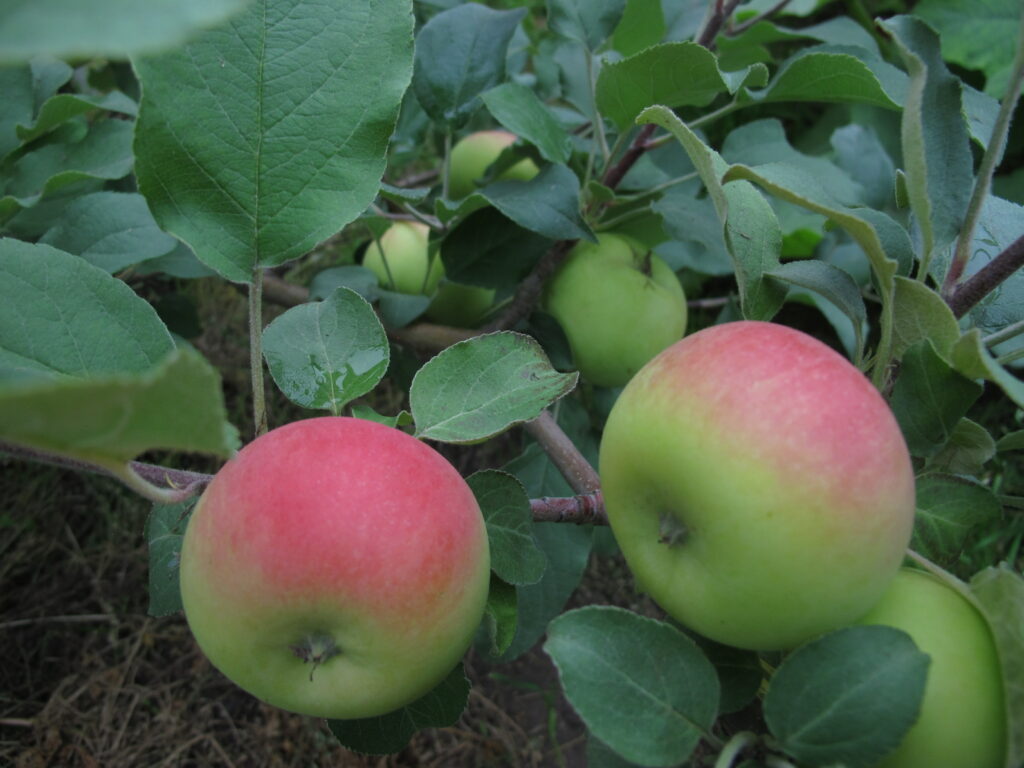
A couple of weeks ago, I was stayed in my tracks as I was strolling by one of our apple shelters. They’re coming, my nose told me as the fragrance of ripe fruit wafted out of the open door. I poked my head in. As luck would have it, beneath the laden branches lay a dropped apple that hadn’t yet been gnawed on by rodent or dog. A rose blush had been creeping over the sunny side of the Nordas for weeks, but the background of bright green was only just beginning to pale to yellow. I bit into the apple and closed my eyes. This is the taste of fall. For us, it is also a sort of validation for all the work we go through in the other three seasons to keep the trees healthy and happy. And, it is a reminder that we need to pick the darn apples.
Surely there is no art to this part of the apple project. You’ve planted an apple tree, fed it well, kept the dogs from peeing on it through the winter, protected its blooms and thinned its fruit … now we just pick, right? Sort of—the devil being, as always, in the details. Knowing when to pick is another learned skill, depending on the tree and the proposed use of the fruit. Just like berries, some apples hang on better than others once they ripen, while others need to be picked and eaten early lest they fall and turn to mush. Colour is only one aspect of ripening, and it has different facets: the blush of pink or red that we associate with a ripe apple can come on very early and is much more pronounced when fruit is exposed to sun. The background colour is the key to ripening—it will shift from green to pale yellow (e.g., Norland), bright yellow (e.g., Trailman) or cream (e.g., Parkland) when the apples are truly ripe. Some, like Rescue, go truly red in their entirety. If you must test early (and surely you must), note the colour of the seed. They start as little white nubbins, swelling to full size before turning brown. A fully ripe apple has completely brown seeds. Aroma is the third character, bringing the second sense into play, as fragrance develops with the final ripening. This is very developed in certain apples, such as Norda and Battleford.
Now we know when apples are ripe. So that’s when we pick them, right? Again, a seeming no-brainer, but there are options. As is the case with many fruits (think bananas in shipping containers), most apples keep better when picked a little shy of full maturity. Norland, for example, can gain two weeks of keeping ability if they are picked when the seeds are only half brown. A fully ripe Norland straight off the tree is a fine thing, however, so if your crop is small enough to be devoured fresh, let it be so. The same could be said for Prairie Sun, Parkland, Rescue and other short-term keepers. Late apples harvested for longer-term storage, on the other hand, can actually taste better after a month in storage. This group includes Festive Treat and September Ruby. Autumn Delight and Norda can keep through to April, albeit with a little loss of flavour and texture, and do so better if picked a tad early. All of these changes over time are, of course, subject to the vagaries of the season and storage conditions.
Autumn Delight and September Ruby are examples of apples that can hang on after maturity, whereas Battlefords drop the moment they ripen. The short-term keepers, in general, begin to deteriorate on the tree, so don’t wait for them to fall! Some apples, like Festive Treat and Prairie Sun are prone to dropping their fruit prematurely if they are carrying too heavy a crop (see article on fruit-thinning). Poor management of water and/or nutrition over the season can also trigger fruit drop at any point. If you have to go away for a moose hunt before apple harvest, it may be wise to engage the services of a young neighbour to watch your tree, unless it is a late storage apple.
If none of these names mean anything to you, don’t despair. While I am now capable (on most days) of rattling off the names of all of the 60 or so varieties of apples we currently have under trial, I confess that when I first arrived in Klondike apple-land I could name only a couple I had read about in a seed catalogue. You won’t find Gala or Red Delicious here. This begs the question for any of the varieties we carry: So what does it taste like, when it’s ripe? I admit to being rather stumped at this question beyond super-sweet (Trailman and Noret) through to a balance of sweet-tart (Rescue, Norland, Parkland). By the by, they are all, in my humble opinion, delicious. It’s just that my vocabulary for tastes and aromas needs some work; perhaps I could work in some adjectives from our Scotch club cheat sheets—fresh-mown grass, or old books? More useful might be to try to match up our cultivars with familiar grocery-store stock. Fort Mac Mac is, well, a mac-type apple. Norland, Parkland and Norda could all hang out in the same boat as Gala and Fuji. Trailman and Noret are better compared to cherries on the sweetness scale. These comparisons don’t really do our Yukon-hardy contingent justice however, as they are each wonderful in their own right … it’s just a matter of finding out which one suits your palate.
Together, they do taste of fall … and winter, and spring and summer—because growing the trees and giving them the care they need to fruit in our less-than-ideal climate takes effort throughout the year. We’ll get to the winter part soon enough, but for now … let the harvest begin!




